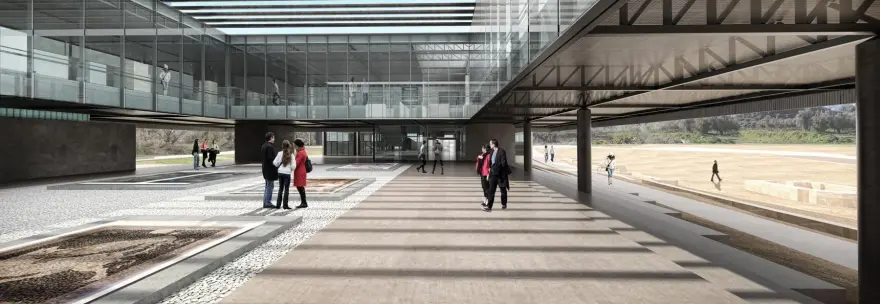Sparta: This is what its new Archaeological
Museum will look like
Original Greek published in Proto Thema, 09.11.2023. The images are from the same source.
https://i1.prth.gr/images/1168x656/_webp/files/2023-11-09/Arxaiologiko_Mouseio_Spartis_1.jpg
How will
its spaces be configured and which functions will they host
The
procedures for the creation of the new Archaeological Museum of Sparta are
entering the final stretch after the approval of the final studies, which were
drawn up in the framework of the Cultural Development Program Agreement with
the Region of Peloponnese, with a budget of 2,750,000 euros.
 |
| The existing listed building |
 |
| View of the completed new facility |
The study
for the New Archaeological Museum of Sparta follows two axes: a) the
restoration of the old shell of the preserved industrial building of the old
HYMOFIX factory in order to include the functions of the New Museum, b) the
addition, by extension, of a two-story building with a basement, so the
building complex covers all the functions of a modern museum, universally
accessible.
In fact,
new parameters were added to the relevant studies, which relate mainly to the
points of contact between the surrounding area and the building, while the
final study - the architecture, the statics and that of the electromagnetic
installations - is modified in the New Archaeological Museum of Sparta,
maintaining, however, visible and visitable architectural remains that were
revealed.
As the
Minister of Culture Lina Mendoni stated "In the architectural approach,
emphasis was placed on preserving and highlighting the main aspect of the
building-monument of the HYMOFIX industrial complex, which preserves the
principles of the building's design (1957) by the architect Takis Zannetos and
on preserving of the interior of the building, so as to recall its industrial
character. At the same time, the conservation and the best possible viewing of
the antiquities revealed by the excavation research is achieved, within the
outline of the basement of the new building. The New Archaeological Museum of
Sparta, in combination with the modernization of the existing cultural
infrastructure - a total upgrade of the Old Archaeological Museum of Sparta and
restoration of the "house of Europe" - further upgrades the cultural
identity of the city by highlighting, in a modern way, its extremely important
cultural stock, contributing at the same time to the promotion and
consolidation of a new, sustainable development model for Lacedaemon centered
on culture".
 |
| View from inside the New Archaeological Museum of Sparta |
The New Archaeological Museum is located within the archaeological site of Sparta, on a plot of land of more than 20 acres, at the northern end of the city. Based on the approved studies, the property of the former HYMOFIX factory is used, whose main building - without the additions - has been designated a monument. It is a representative example of an industrial building of the modern movement. In the year 1959, the two-story and three-story part of the building was constructed, two years later its single-story extension and then its extension in the form of a shelter. In 2005, the YPPOA bought the property from the National Bank for the location of the New Archaeological Museum of Sparta. In 2020, the architectural preliminary study was approved which included the building of the HYMOFIX factory designated as a monument, as well as new extensions, in contact with the monument.
In the
context of the excavation research carried out in the basement of the New
Museum, in a total area of 1,350 sq.m., an undisturbed, extensive horizon of
use, from the late archaic and classical periods, as well as important
architectural remains, among which a construction with a series of rectangular
and square cobblestone bases of columns or peg-shaped supports, which must
belong to an important public building, within a purely archaic layer, in a Π-shaped arrangement. In relation to the original study and due to the
antiquities, modifications were made that mainly concern the points of contact
with the environment space with the building itself, on the west and north
sides and partly on the south.
 |
| Illustration diagram of the spaces of the new museum |
Regarding
the functional organization of the spaces, the basement is developed on two
levels. On the lower level there are, among other things, three distinct main
storage areas for ceramics, mosaics and sculptures, smaller storage areas for
excavation finds, a treasury, the central elevator. On the second level, the
air-conditioning machine room, the central staircase, sanitary facilities, the security
staff's office and the control room are located. The ground floor is also
developed on two levels. On the lower level, the spaces for parallel events and
periodical exhibitions, the Cafe, the shop, and public service areas are
created. On the upper level of the ground floor, the main exhibition hall,
study areas, laboratories and sanitary areas are to be found, while there is a
connection to the outside area. On the first floor, in the addition of the
existing HYMOFIX factory, the functions include the four stairwells, the
elevators, WC for the public and the disabled, two warehouses for exhibition
items and permanent exhibition spaces. The addition is connected to the floor
of the old HYMOFIX factory. The first floor of HYMOFIX includes a room for
educational activities, WC for the offices, stairwells and two elevators.
Finally, the area of the existing reservoir houses mechanical installations.
The study makes allowances for the exploitation of the former boiler room of
HYMOFIX, which is an independent construction. On the ground floor there are
offices, WC, kitchen, staircase and elevator. On the ground floor there is a
guest house, offices, a scientific documentation archive and a stairwell with
an elevator.
No comments:
Post a Comment